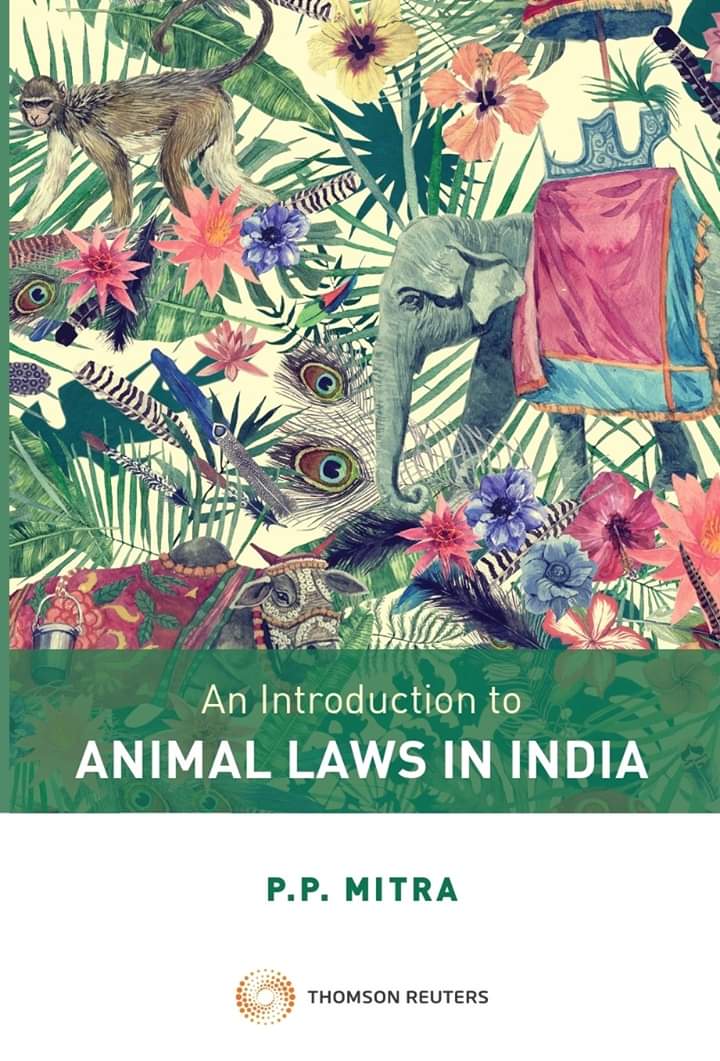BOOK REVIEW
An Introduction to Animal Laws in India by PP Mitra
Dr. Caesar Roy reviews this book on the importance of a shift and dire need in animal protection and safety laws and texts under the Indian context.
 An Introduction to Animal Laws in India by PP Mitra
An Introduction to Animal Laws in India by PP Mitra

In light of the contemporary debates in Indian society on the necessity and extent of protecting and recognizing legal rights of animals, there is an inclination in the legal society to recognize the importance of respect and protection of animals. As per the ancient Indian culture, animals are regarded as divine beings. Presently, animals hold various roles, such as agricultural and transportational purposes in the rural areas, pets as companions, in sports, circuses or zoos for entertainment, scientific experiments in the educational sectors in science and research etc. Animals have a major contribution to the Indian diet. Since the inception of mankind, humans have been dependent on domestic creatures. Hence, these animals must be protected by the means of law. There are various guidelines in the ancient religious scriptures of India for the protection of animals. India has some provisions in the Constitution and some acts, rules and regulations relating to protection of animals in India.
"An Introduction to Animal Laws in India" discusses all types of laws relating to animals and their rights— from wild animals to domestic animals, cattle to foreign and migratory animals. This book is a compendious piece of legal materials as it comprises animal related laws containing acts, relevant provisions of other statutes, rules and orders passed there under, the state enactments and rules and judicial decisions.
Meticulously summarised in the book, the author lists many facts from concerned case laws. The statutes, rules and orders have been reproduced in a systematic manner, supported with the amendments wherever made. The book is divided into nineteen chapters. The ‘Introduction’ of the book gives an apt foundation of the subject, covering the position of animals within human law. Chapter two, “Animal Rights and Laws” starts with a basic question whether animals can even be regarded as persons. The meaning of animal rights, position of animals under law of torts, provision of animals on the highway along with the Scienter Rule, position of animals under criminal laws and the principles of ownership of animals are minutely discussed in this chapter.
Next Chapter “Animals in International Law” prescribes guidelines of the World Health Organization of Animal Health (OIE) on the five freedoms of animal welfare. The role of the Universal Declaration on Animal Welfare, the World Health Organization for animal healthInternal League for Animal Rights, The European Union’s Convention on Animal Protection and various other international conventions for wild animals have been highlighted here. In the next chapter, “Constitutional Position of Animals in India”, the Entries of State List, Union List and the Concurrent List of our Constitution relating to animals, birds and fisheries are the main themes. The Right to Life of animals under Article 21, animal husbandry and prohibition of cow slaughter under Article 48, safeguarding the wildlife under Article 48A, compassion for living creatures under Article 51A(g) of the constitution have been analyzed here. Chapter five is “Cattle Preservation and Livestock Improvement” where the author emphasizes the provisions of cattle and livestock under various Entries of the Lists of the Constitution, registration of cattle premises along with the` Goshalas and Gosadans with various relevant judgments. The regime on cattle trade and animal market, regulation and control of the cattle fairs throughout the various states in India with several state legislators, cattle trespass, cattle smuggling, various Acts on livestock improvement and idea about agricultural produce and livestock market are put forth punctiliously in this chapter. The following chapter, “Prevention of Cruelty to Animals” marks the core theme of the book. The Prevention of Cruelty to Animal Act, 1960 with various other acts Rules and relevant provisions of the Constitution relating to cruelty to animals in India are discussed in this Chapter. Provisions for control of stray animals by local authorities with judicial observations, laws to prevent sexual offences against animals are the issues tackled in this chapter. The next c “Sacrifice of Animals” deals with the conflict between morality and religion. This chapter highlights the treatment of animals on specific occasions, the practice of animal sacrifice as religious customs, right of freedom to profess, relevant state laws on prohibition of animal sacrifices and provisions in the constitution of India with some judicial decisions on sacrifice prohibition. Chapter nine, “Experimentation on Animals” is another area where animals are used by man for scientific experiments and medicinal inventions since time immemorial. But there are some regulations on clinical trials and medicinal tests prevailing in India. The Judiciary has also delivered critical decisions on experimentation on animals. This chapter includes the recent 261 st Report of the Law Commission of India to regulate dog and aquarium fish breeding in India. Chapter ten is about “Performing animals”, which explores the use of animals for the purpose of human entertainment in festivals such as Jallikattu in Tamil Nadu, tonga race in Rajasthan and bullock cart race in different parts of the country. This book discusses a series of judicial pronouncements banning such types of inhumane practices and also balancing the conflict between performing animals and culture and tradition in India. The prohibition of showing the cruelty and abuse of animals under Cinematograph Act, 1952 and allied rules have been discussed with the guidelines of the Committee of Expert constituted by the Ministry of Information and Broadcasting, Govt. of India. The Chapter “Transportation of Animals” analyzes relevant laws on the transportation of various animals by different modes, transportation of animals before slaughter, general conditions for maintaining general hygiene and sanitary practices by food business operators and the regulations for loading of animals and guidelines for space requirement during transportation. Reference is given from the 269th Report of Law Commission of India on provisions of transportation of egg-laying hens and broiler chickens. The book has also mentioned various provisions of different carriage laws in India where animals are defined as goods. This chapter also includes many judicial observations on animal transportation, the restriction of transportation of wild animals and the norms of transportation for elephants under relevant laws. Chapter twelve relating to “Diseases and Treatment of Animals” explains animal diseases under the entries of the seventh schedule of the constitution in tandem with various central and state legislations for protection of cattle from diseases. Here the provisions on immunization of communicable disease for wild animals are discussed. Chapter thirteen deals with “Trade of Animals and Birds”, where the selling of animals for various purposes, such as dog breeding and marketing, aquariums and fish tanks, animal shop along with relevant rules and various judicial pronouncements are placed within international instruments and Indian laws. Chapter fourteen “Conservation of Wild Animals”, analyses the constitutional position for wild animals with the 42nd, 73rd and 74th constitutional amendments, various states and central legislations to protect the wild animals, hunting of animals, various categories of protected areas including sanctuaries, national parks, closed areas and game reserves. Many judicial decisions on tiger killing, capture of elephants and trading of ivory are engraved in this chapter. Chapter fifteen is the“Role of Judiciary on Animal Protection in India.” Here several cases are discussed regarding animal protection and analyzed apropos judicial activism under Article 21 of the constitution to protect the wildlife and the application of the doctrine of Parens Patriae. Chapter sixteen examines the “Authorities for the Protection of Animals in India”, wherein the power and functions of various executive and statutory authorities are mentioned. Chapter seventeen deals with “Projects and Policies on Animals in India.” Various national projects and policies for the animals and many conservation programs are discussed by the author in this section. The penultimate chapter eighteen “Consumer Protection and Animal Welfare” analyses consumer rights vis-à-vis animal rights. Here the author describes the laws on meat products and meat shops, the laws on labeling for all packaged food products and several judicial observations on consumer rights. Chapter nineteen concludes the book by highlighting relevant provisions on animal rights and elaborates on the prospect of animal law.
The book offers a crisp and lucid take on animal rights and laws prevailing in India. With summaries of the latest cases and important legal provisions on animals, the book is available in a single bound copy at an affordable price. The discourse is a good is an informative piece of work for teachers, students, researchers, social activists, academicians various NGOs, and for those who are concerned with the bare provisions of the animal laws.
caesarroy123@gmail.com.
- FIR Copy of Mahatma Gandhi assasination case
- Licito Concurso'20
- Rules for Licito Concurso '20- A National Legislative Drafting Competition
- Registration Form for Licito Concurso-20
- www.apexcourtweekly.substack.com
- www.lawupdater.com/wp/
- XIIIth K.K. Luthra Memorial Moot Court Competition 2017
- President of India Presented with the First Copy of the Book Statement of Indian Law Published by Thomson Reuters





